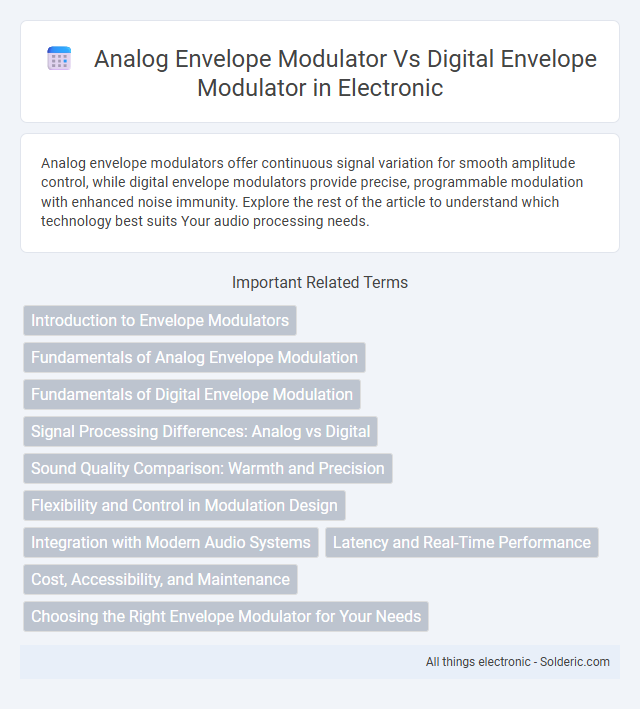Analog envelope modulators offer continuous signal variation for smooth amplitude control, while digital envelope modulators provide precise, programmable modulation with enhanced noise immunity. Explore the rest of the article to understand which technology best suits Your audio processing needs.
Comparison Table
| Feature | Analog Envelope Modulator | Digital Envelope Modulator |
|---|---|---|
| Signal Type | Continuous analog signals | Discrete digital signals |
| Modulation Accuracy | Lower, affected by component tolerances and noise | Higher, precise control via algorithms |
| Flexibility | Limited, fixed circuit parameters | Highly flexible, programmable parameters |
| Complexity | Simple circuitry | Requires DSP hardware and software |
| Power Consumption | Typically lower power usage | Higher power due to processing |
| Latency | Minimal, real-time operation | Some processing delay |
| Noise Immunity | Susceptible to analog noise | Resistant, digital noise reduction |
| Applications | Traditional audio, radio modulation | Modern communication, music synthesis |
Introduction to Envelope Modulators
Envelope modulators shape the amplitude contour of a carrier signal to encode information efficiently in communication systems. Analog envelope modulators use continuous-time components like diodes and capacitors to create smooth voltage transitions, while digital envelope modulators employ discrete signal processing techniques for precise and programmable control. Your choice between analog and digital depends on factors like signal fidelity, complexity, and application-specific requirements.
Fundamentals of Analog Envelope Modulation
Analog envelope modulation involves varying the amplitude of a carrier signal in direct proportion to the instantaneous amplitude of the baseband message signal, creating a continuous waveform that reflects the envelope. It relies on analog circuits such as diodes, transistors, or operational amplifiers to achieve real-time amplitude variations without quantization errors. The fundamental advantage of analog envelope modulation lies in its simplicity and natural representation of the signal envelope, contrasting with the discretized processing inherent in digital envelope modulators.
Fundamentals of Digital Envelope Modulation
Digital envelope modulation processes amplitude variations through discrete-time signal sampling and digital signal processing algorithms, enabling precise control and flexibility in communication systems. Unlike analog methods that rely on continuous voltage changes, digital modulation encodes the envelope using binary data streams, improving noise immunity and integration with modern DSP hardware. Key components include analog-to-digital converters (ADCs), digital envelope detectors, and digital-to-analog converters (DACs), which collectively support efficient and accurate envelope extraction and reconstruction.
Signal Processing Differences: Analog vs Digital
Analog envelope modulators process signals continuously using electronic components such as diodes and operational amplifiers, resulting in smooth, real-time envelope extraction but with susceptibility to noise and component tolerances. Digital envelope modulators sample the input signal and perform envelope detection using algorithms like Hilbert transform or peak detection in a discrete-time domain, offering higher precision, flexibility, and resistance to noise. The digital approach enables advanced signal manipulation and integration with other digital processing stages, contrasting with the inherently nonlinear and less adaptable nature of analog processing.
Sound Quality Comparison: Warmth and Precision
Analog envelope modulators deliver a warm, natural sound characterized by subtle harmonic distortion and smooth dynamic shaping, which many musicians and audiophiles prefer for its organic feel. Digital envelope modulators offer higher precision with consistent, repeatable modulation parameters that enhance clarity and detail in your audio production. Choosing between the two depends on whether you prioritize the analog warmth or the digital accuracy in your sound quality.
Flexibility and Control in Modulation Design
Digital envelope modulators offer superior flexibility and control in modulation design due to their programmability and ability to implement complex algorithms for precise shaping of the amplitude envelope. Analog envelope modulators, while simpler and faster in real-time response, provide limited adaptability and rely on hardware components that restrict modulation pattern customizations. Digital systems enable dynamic parameter adjustments, automation, and integration with other digital signal processing techniques, making them ideal for advanced and versatile modulation schemes.
Integration with Modern Audio Systems
Analog envelope modulators rely on continuous voltage control, offering smooth and natural transitions ideal for classic audio equipment but face challenges in seamless integration with modern digital audio workstations and software-based systems. Digital envelope modulators use discrete signal processing, enabling precise, programmable, and easily automatable control that aligns with contemporary digital audio interfaces and MIDI protocols. The digital approach enhances compatibility with advanced audio production tools, facilitating improved synchronization, recallability, and flexibility in modern studio environments.
Latency and Real-Time Performance
Analog envelope modulators offer near-zero latency and superior real-time performance due to their continuous signal processing without the need for digitization or buffering. Digital envelope modulators introduce latency caused by analog-to-digital conversion, processing delay, and digital-to-analog conversion, which can impact time-sensitive audio applications. Optimizing digital algorithms and hardware acceleration can reduce latency, but analog modulators remain preferred for ultra-low-latency environments requiring immediate response.
Cost, Accessibility, and Maintenance
Analog envelope modulators generally incur lower initial costs due to simpler circuitry but may require more frequent maintenance because of component wear and drift. Digital envelope modulators offer greater accessibility through software updates and programmable features, reducing long-term maintenance expenses despite higher upfront costs. The choice between the two balances immediate affordability with operational flexibility and reliability over time.
Choosing the Right Envelope Modulator for Your Needs
Choosing the right envelope modulator depends on your specific application requirements, with analog envelope modulators offering smooth, real-time signal processing ideal for audio and RF systems requiring low latency. Digital envelope modulators provide greater precision, flexibility, and programmability, making them suitable for complex communication systems and environments demanding adaptive modulation schemes. Your decision should weigh factors like signal fidelity, processing speed, and integration with existing digital infrastructure.
Analog envelope modulator vs digital envelope modulator Infographic

 solderic.com
solderic.com